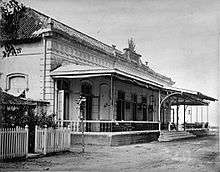Military Canteen of Royal Netherlands Navy

Late 19th century

Circa 1929

New building under construction circa 1930
'_TMnr_10014827.jpg)
Aerial photo
The Military Canteen of Royal Netherlands Navy (also known as the Marine Societeit Moderlust Ujung) was built in Soerabaja, Dutch East Indies (present-day Surabaya, Indonesia) in 1890. The canteen was a place for socializing and was known as Marine Societeit "Moderlust" (Mud Lust) Ujung after May 1867.[1]
The crew of submarine HNLMS K XVIII visited the canteen during their stay in Soerabaja in 1942.[2] The sub was eventually scuttled ahead of the Japanese advance and was later raised by the Japanese as a "picket hulk" in the harbor. It was later sunk by HMS Taciturn.
Societeit clubs were popular in cities across the Dutch East Indies.[3]
References
- ↑ "Online Catalog - Digital Collections - Marine Societeit Moderlust - jiunkpe/mmedia/pust/unknownyear/". Retrieved 23 August 2015.
- ↑ "Maritiem Digitaal". Retrieved 23 August 2015.
- ↑ "Virtueel Indië". Retrieved 23 August 2015.
This article is issued from Wikipedia - version of the 1/28/2016. The text is available under the Creative Commons Attribution/Share Alike but additional terms may apply for the media files.
